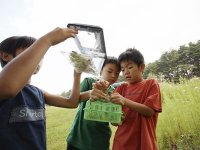Into the Wilderness: Expanding the Lives of Kids
My wife and I were recently hiking up a beautiful canyon in Glacier National Park and joined a small group of college students on a research trip with their botany teacher. It started to rain and we all got soaked, but the feeling of connection we had with these students and the joy coming from each of us as we continued to walk and talk in the rain became part of what was a peak experience. We were each alive with vibrant energy, and even the rain was part of that.
On one of our ranger-led hikes in the park, I met a young woman who was picking up additional ideas to bring the wilderness experience into her work with preschool children. I mentioned Richard Louv's marvelous book Last Child in The Woods: Saving Our Children from Nature-Deficit Disorder, and her face lit up. "That book is fantastic!" she said. "It is my inspiration." She was familiar with Edutopia, and I told her she'd find writing here that could also be a help.
A few days later, we were hiking on Mount Washburn in Yellowstone National Park, and as we descended, we met a group of multiracial teenagers coming up the mountain who were part of the Overland Summer Program. They were from cities all over the U.S. and, with the Overland leaders, were filled with an excitement and energy that I rarely see in teens in their daily lives in school. I'm sure it was a first time for each of these kids.
Finding Power and Meaning in the Natural World
These are not isolated experiences. Every time we explore these parks, we are not only personally renewed and infused with a feeling of being alive that often gets lost in our routinized lives, but we always meet and/or observe kids of all ages who I know are also having very meaningful experiences. Each of these encounters reminds me of how little the connection between kids and the wilderness is part of the school experience, and I'm reinforced in my belief that this should be a priority in all schools.
Synchronistically, just after we returned, my wife found this article about a program that uses nature photography to help at-risk teens. As in many of the programs across the country, the focus is on using the wilderness experience to help at-risk kids. But the fact is that most of our teens are in some way at risk and can benefit equally from these programs.
To cap off this continuing series of reminders about the importance of the wilderness in kids' lives, a few days after returning home I went to see Richard Linklater’s remarkable film Boyhood. Among the many memorable moments in the film are a few set in the wilderness in which the boy, Mason, becomes unusually open and intimate with his father in one scene, and with friends in another. In the final scene, Mason, his roommate, and two young women choose to skip a freshman orientation mixer at the university and instead go to Big Bend Ranch State Park, one of the most beautiful wilderness settings in Texas. Mason and his new young woman friend have an open, intimate conversation against this backdrop as the film ends. Linklater clearly had a sense of the importance of place and of the wilderness in the process of growing up.
Getting Out of That Small Corner
In Letters to a Young Poet, Rainer Maria Rilke wrote, "If we think of [the] existence of the individual as a larger or smaller room, it appears evident that most people learn to know only a corner of their room, a place by the window, a strip on the floor on which they walk up and down."
I spend a lot of time with adolescents whom I call the creative dissidents, kids who are often very alive with ideas and energy, but are wrestling with somehow feeling trapped in their lives, including their lives in school. Many of our kids know that they want to get out of their corner of the room.
It can be argued that this is a challenge for parents and kids, not for schools, but I strongly disagree. This should be woven into the schooling experience of every kid, whether through an exploration of a local beach or wilderness park, or through planned, extended wilderness excursions. Louv's book can help with ideas, as can a book I've mentioned before, Companions in Wonder: Children and Adults Exploring Nature Together, edited by Julie Dunlap and Stephen Kellert.
But there is one piece missing -- this needs to begin with teachers and parents. They need to have this experience themselves. To that end, you might take a look at Louv's most recent book, The Nature Principle: Reconnecting with Life in a Virtual Age.
I know this isn't part of Common Core and is thus implicitly made a low priority, but I can think of no better way to get out of that corner Rilke describes than to spend time in the wilderness. There is something about being in the woods -- encountering wildlife, dealing with ice on a mountain climb, feeling rain on a trek through new territories -- that can be life changing. Let's make sure we give our kids that opportunity.
